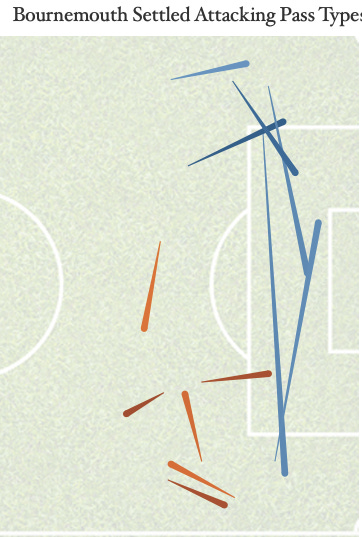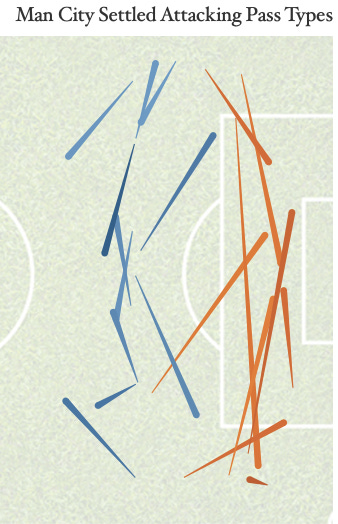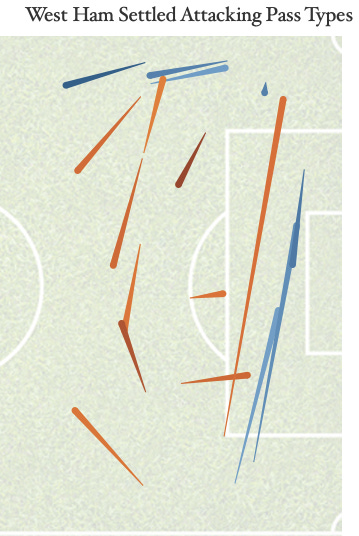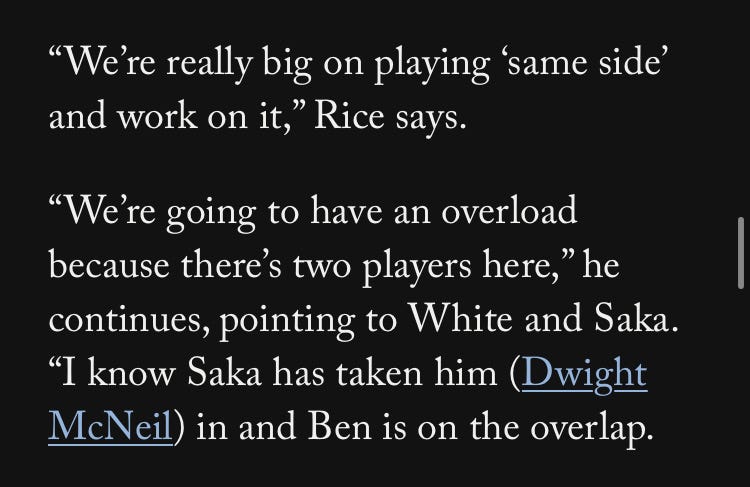Becoming a Better Fan Series: Settled Attacking Possession
charts, writing, video clips and more
This is part two of the Becoming a Better Fan Series. Where I am basically trying to figure out how to better understand parts of this game that just don’t click to me. We want to learn things that aren’t obvious, that help us understand how teams tick and work so we can enjoy and comprehend the chaos of bodies and movement that bursts out of our TV screen or stadium experience every week.
Part one on regains and what teams do after is here.
Today we are talking settled attacking possession. So often this is what you see in a good vs bad matchup, where West Ham or whoever just sit back against Liverpool and Liverpool just hold the ball for a long time. It can be sort of mind-numbing to watch too many of these games and often it all looks the same. Sort of moving the ball around a bunch of guys looking for a mistake. But that can’t be it, surely? This article will try and see how teams differ in their approach to settled attacking possession.
Definitions
Passes starting past the 70% mark of the field and made after a team has held the ball for 8 seconds or more. While my Possession Time column is not exact, it is quite close enough for our purposes here. We don’t want a lot of breakaway possession where the game is stretched here, we don’t want regains popping up, we want the defense to be pretty much back in place and teams trying to break opponents down.
Let’s take a look at a few typical sequences to get our mental picture nailed down.
Most of you could create those in your mind already, just a double check to make sure we know what we are talking about.
How Often Does This Situation Happen
From a low of 19 passes per game (Sheffield United) to a high of 99 passes per game (Man City). The average team plays 46 per game, this feels roughly correct in my mind, we are talking about a bit under 10% of a teams passes per game. These passes are quite crucial though, the average pass in this area leads to a shot within 15 seconds 19% of the time (of course many are in a sequence leading up to one shot), which is over 4x a pass outside this zone.
Another, better way of explaining the importance of this area is looking at the xThreat map. Sort of why I dislike so many of the “progressive passes” or “final third entry” stats over the years is that entering the final third is just not really that valuable at all. It’s what you do once you are there that creates the value.
We come to our first Saturdays-created chart of the day, but trust me it will not be the last. Just a quick glance at who passes a lot overall in attacking areas in settled possession and who keeps/loses the ball.
No real surprises here, maybe Liverpool being so low kind of makes one realize just how transition oriented they have been that they have fewer settled possession attacking passes than United and Chelsea, much less Brighton and Spurs.
Luton and Everton’s total indifference to completing passes stands out as well along with Champions League likely entrant Aston Villa eschewing this style of play (or unable to build it).
And West Ham, my god.
Here we see Aston Villa look more like a Champions League team, with Everton also standing out for how hard it is to complete passes against them once they get their block setup.
Man United look incredibly soft (and will look softer once we dive in more).
West Ham, my god.
And what is going on at Brentford, noted analytics voices were recommending Frank to be hired at Liverpool but his team can be very hard to figure out at times what exactly they are going for.
A reminder again that Chelsea is not Manchester United. Both have had poor points totals but Chelsea have showed many more overall flashes of quality.
Shot Generation
Arsenal use 14 passes/take ons to generate a shot on average in these situations, City are the only ones even in that neighborhood up above 12. Interestingly, neither team gets closer shots on average from all this. The main benefit lies in keeping the ball, keeping their opponents pinned down and building shot volume edges. The shot distance could be a bit misleading (looking at you Luton) as I didn’t filter headers from kicks. If you want that filter, you should have signed up for the ultra-premium plan*.
Brighton are generally involved, labored and extra-precise building up their attacks in their own half but once they are near goal here they become more direct.
No surprise we see Everton not wasting any passes getting the ball on goal.
Arsenal actually do not have a big volume of shots from these situations which is surprising to me. Need to look into exactly where so many of their shots come from as both Spurs and Brighton generate more per game from these settled forward possessions.
*such plan does not exist for the hordes looking to sign up to pay money for more newsletters, I am sorry for turning down the possible $6.77 a month I could earn.
Burnley stand out here in terms of the quality of shot they allow, the broad criticism of too soft defensively can probably be pinned down in open play to they allow way too good of shots in settled possession.
Manchester United allowing over 7 shots per game from these situations is simply absurd, only Sheffield United allow more. Manchester United also allow opponents to fire shots quickly despite being in situations like this a ton, unlike West Ham or Brentford who kind of slow opponents down and make them work.
Everton and Burnley are great comparisons, which one has Dyche and is keeping the shots far from goal.
While the Big 3 wind up giving up shots at an average or above average pace, I assume that broadly comes from teams firing at the first possible opportunity. That looks reflected in the shot distance.
The stylistic parts of the attack
City’s distinctiveness with regard to Arsenal show up here. They love conservative passing and sort of pushing back opponents through carrying the ball forward (and possibly then recycling possession back to do it again.
Arsenal and Spurs are conservative passers but use the carry less often in these situations than City, Brighton and Chelsea.
Kompany’s Burnley the only team above 50% of their Fields Gained through carry alongside Pep. As with many of Kompany’s tactics you wonder if he’s sort of copying Pep for stylistic reasons and that maybe it’s not the best idea to play that style with a relegation threatened team without the player talent or profiles of an Arsenal or Man City.
Unsurprisingly Everton are at the top of the vertical pass list. Brentford and Fulham are not carrying the ball almost at all, it’s all the ball doing the work. 15 passes for every take on for Brentford, Fulham are at 17.4! Wolves are at 8, West Ham at 7 for example.
Another difference between City and Arsenal comes with where the ball is. City are central more than 50% as often as Arsenal. Look at what Declan Rice says about their final third play to sort of understand why:
Part of a fantastic article in the Athletic that has Rice basically describing how Arsenal train and how he sees his game. While making money for sportswriting on the internet is clearly a profession heading the way of money manager, travel agent or coal miner, the Athletic is still a pretty good read for a sports fan while it is still living and burning cash.
Putting it all together
Let’s look at two teams offensively and a team defensively and put it in plain-ish english what we have learned so far.
We use our old standby, the k-means clustering tool based on pass start and end to separate the teeming mass of pass data in 40 clean pass types, presented here (color indicates how often a shot results within 15 seconds of a pass being played)
I will pull out a few examples and then put the entire mass at the bottom.
Arsenal are not going to bang in long crosses, they have a lot of close interplay down Saka’s side and the left side is often just bringing the ball back central.
Clip of Arsenal's heavily used passes
Arsenal have played these right wing recycling type passes leading to a shot 72 times in the opening 30 game weeks this season. No other team has more than 40. Every Arsenal fan will be able to recognize that pattern in the clip above.
One more Rice quote
Everton however, are never bringing the ball backwards to reset play, they are rarely accessing the right side of the box for short passing game but they are definitely banging in crosses.
Brighton have tended to use the left side massively more than the right. Estupinan and Mitoma are two of the better attacking players in the league and they’ve lacked difference makers down the right so you get a settled attacking pass map like this.
Brighton Goal From Left Sided Settled Possession
Chelsea have a bit of a mirror image (with less box penetration) as they’ve lacked pop and volume down the left all season.
Man City certainly play conservatively, we saw that earlier and we see it even more clearly here. Defensive possession is what Pep knows, but maybe the dirty secret is even Pep doesn’t know how to get goals if a team sits really deep.
All teams attacking tendencies can be seen here:



















Aston Villa Offense
-get in settled attacking possession an average amount
-keep the ball very centrally
-generally shoot from long distance
-shoot relatively quickly in possession
-utilize the pass significantly more than the carry
-play conservatively with the ball, will not push it toward goal
Tottenham Offense
-get in these situations quite often
-keep the ball at a high rate, generating shots at a relatively quick pace
-play quite conservatively with the ball, don’t push aggressively toward goal
-very rarely cross
-keep the ball relatively centrally
-prefer the pass to the carry
Manchester United Defense
-get into these situations relatively often
-allow boatloads of shots, generally from a long distance, against
-opponents generate shots quickly
-opponents generally play conservatively, not vertical passing
-opponents rarely cross
These short distance horizontal type passes from the side are a Man Utd specialty to allow. They have allowed over 8x as many of those leading to shots as Arsenal or Aston Villa, they allow most in the league. The next two teams are Sheffield United and West Ham.
United vs City In Box Pass Types
Player Standouts
Looking at how often a player plays a certain pass type we can roughly calculate how often we think his passes will be involved in shot buildups. Looking at players who outperform this number gives us this list
Dejan Kulusevski
Joao Pedro
Ben White
Martin Odegaard
Kaoru Mitoma
Son Heung-Min
James Maddison
Vladimir Coufal
Luis Diaz
John McGinn
Chiedozie Ogbene
at the other end of the list we have
Dominik Szoboslzai
Bruno Fernandes
Mykhailo Mudryk
Josko Gvardiol
Bruno Guimaraes
Yves Bissouma
Keane Lewis-Potter
Jordan Ayew
Mohamed Salah
Milos Kerkez
The most efficient players in terms of keeping the ball in these areas
Bukayo Saka
Kyle Walker
Gabriel Martinelli
Phil Foden
Martin Odegaard
Willian
Dejan Kulusevski
Bernardo Silva
Kaoru Mitoma
Moussa Diaby
Harvey Elliott, Tom Cairney, Luis Diaz and Conor Gallagher get honorable mentions.
At the bottom of the list we have
Bruno Fernandes
Mohamed Salah
Alfie Doughty
Luca Koleosho
Dwight McNeil
Mykhail Mudryk
Jordan Ayew
Antonee Robinson
Jack Harrison
Nelson Semedo
so…what exactly am I missing here. Are Salah and Fernandes just not at all good players in settled possession? Just they are the best in the league in transition or after the regain and that sort of covers up their weakness in this area? I do suspect my metric-ing here could be missing something but the rest of the lists sort of feel right. Mudryk and McNeil are basically the must haves on any “struggle to break down a defense” list, and Saka, Foden, Bernardo Silva, Kulusevski, Son on the other list make total sense.
Great receivers on this metrical list bring in names like Haaland, Solanke, Richarlison, Bowen, Watkins, and Groß. Salah and Fernandes are kind of solid on those lists maybe suggesting they function well as finishers/shot getters and not creators against settled possession. Or I am missing something?
Conclusions
Scoring in settled possession is hard. City and Arsenal don’t create amazing shots from it and broadly building a team to get to this area seems to be the differentiator more than the quality of teams in this area. Not saying that everyone is equal here, obviously Man Utd’s defense in these situations is wretched, whatever Burnley are doing offensively isn’t working. But I kind of expected more separation in terms of the high talent teams vs the low talent teams here. It could be a bit counter-balanced by the fact that high-talent teams likely face more bodies behind the ball than low-talent teams.
What’s next
Trying to link this up with the entire match plan. How often teams create from transition, regains and dead balls and trying to sort of figure out how different teams rely on and are strong in different phases.
As always, any comments, criticisms, ideas or questions let em rip in the comments here. I don’t have twitter anymore so ask for the feedback.























